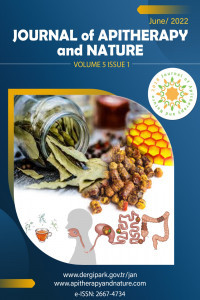Quantitative and Qualitative Variations in Propolis Collection
Quantitative and Qualitative Variations in Propolis Collection
Propolis, antioxidant activity, total phenolic content,
___
- .
- Yayın Aralığı: Yılda 2 Sayı
- Başlangıç: 2018
- Yayıncı: Oktay YILDIZ
What We Know, and Don't Know, about the Benefits of Propolis to Honey Bee Health
Flavonoids Constituents of Algeria Propolis
Segueni NARIMANE, Jesus. G. DIAZ, Akkal SALAH, Rhouati SALAH
Bíliková KATARÍNA, Yamaguchi YOSHIHISA
Chemical Profile and Botanical Origin of Stingless Bee Propolis from Thailand and Indonesia
Direct Visualization of Artepillin C into Fibroblast Cells via CARS Microscopy
Wallance M. PAZIN, Vita SOLOVYEVA, Tibebe LEMMA, Bjarke JØRGENSEN, Carlos José L. CONSTANTINO, Jonathan BREWER
Effect of Brazilian Propolis-containing Ointment on Genital Itching in Menopausal Women
Hiroshi MIURA, Yasuko MIURA, Yuki SHIMODA, Satoko KAGABU, Hiromitsu TSUBAKI, Yukihiro TERADA
Chemical Composition of Selected Propolis Samples from Kyrgyzstan and Kazakhstan
Argyro PETROPOULOU, Konstantia GRAIKOU, Jaroslaw WIDELSKI, Krystyna SKALICKA-WOŹNIAK, Zuriyadda SAKIPOVA, İoanna CHINOU
Thirteen Flavonoids from Green Propolis from Minas Gerais, Brazil, Analyzed for Six Years
M. D. FREITAS, G. A. LOPES, N. A OLIVEIRA, B. M. ALMEIDA, S. R. L. ABREU, R. C. BASQUES, N. S. BINDA, S. M. FIGUEIREDO
Antituberculosis Activity of Propolis
Jarosław WIDELSKI, Joanna GOLUS, Piotr OKIŃCZYC, Rafał SAWICKI, Grażyna GINALSKA, Tomasz MROCZEK, Zuriyadda SAKIPOVA, İoanna CHINOU, Krystyna SKALICKA-WOŹNIAK
Some Apitherapeutic Properties of Chestnut Propolis
Sevgi KOLAYLI, Saliha EKSI, Zihni YAZICI, Oktay YILDIZ, Hüseyin SAHIN, Zehra CAN, Sengül KARAOGLU
